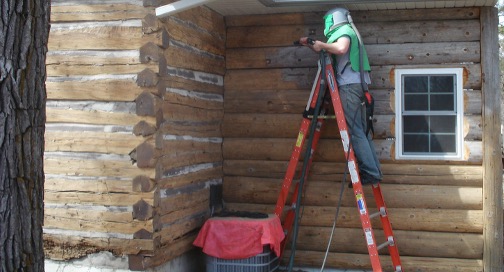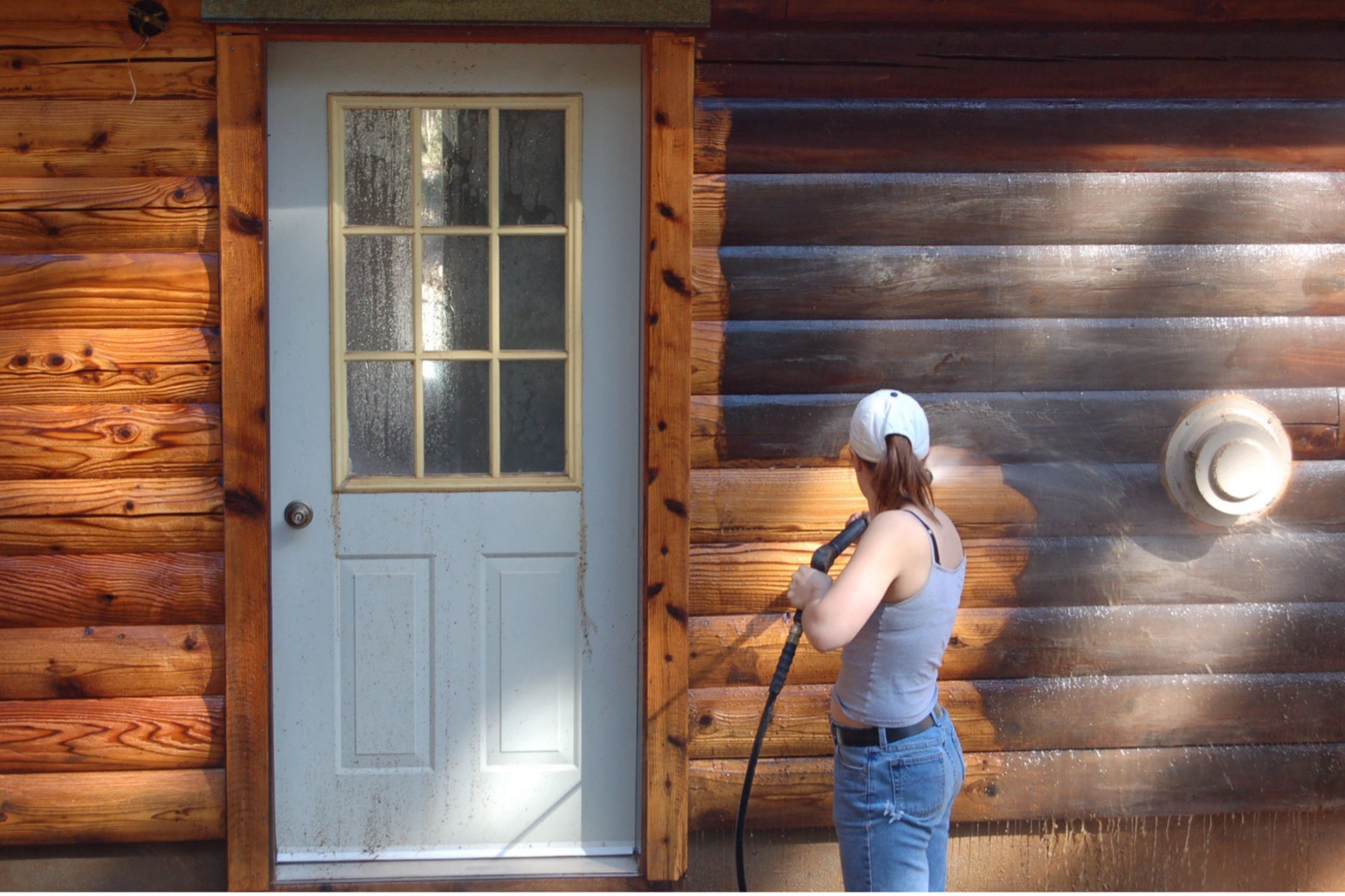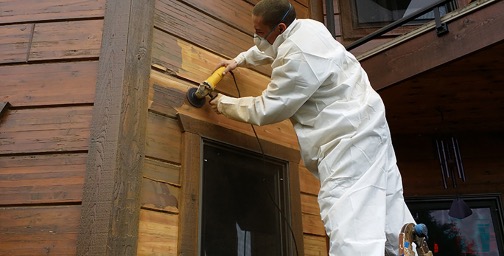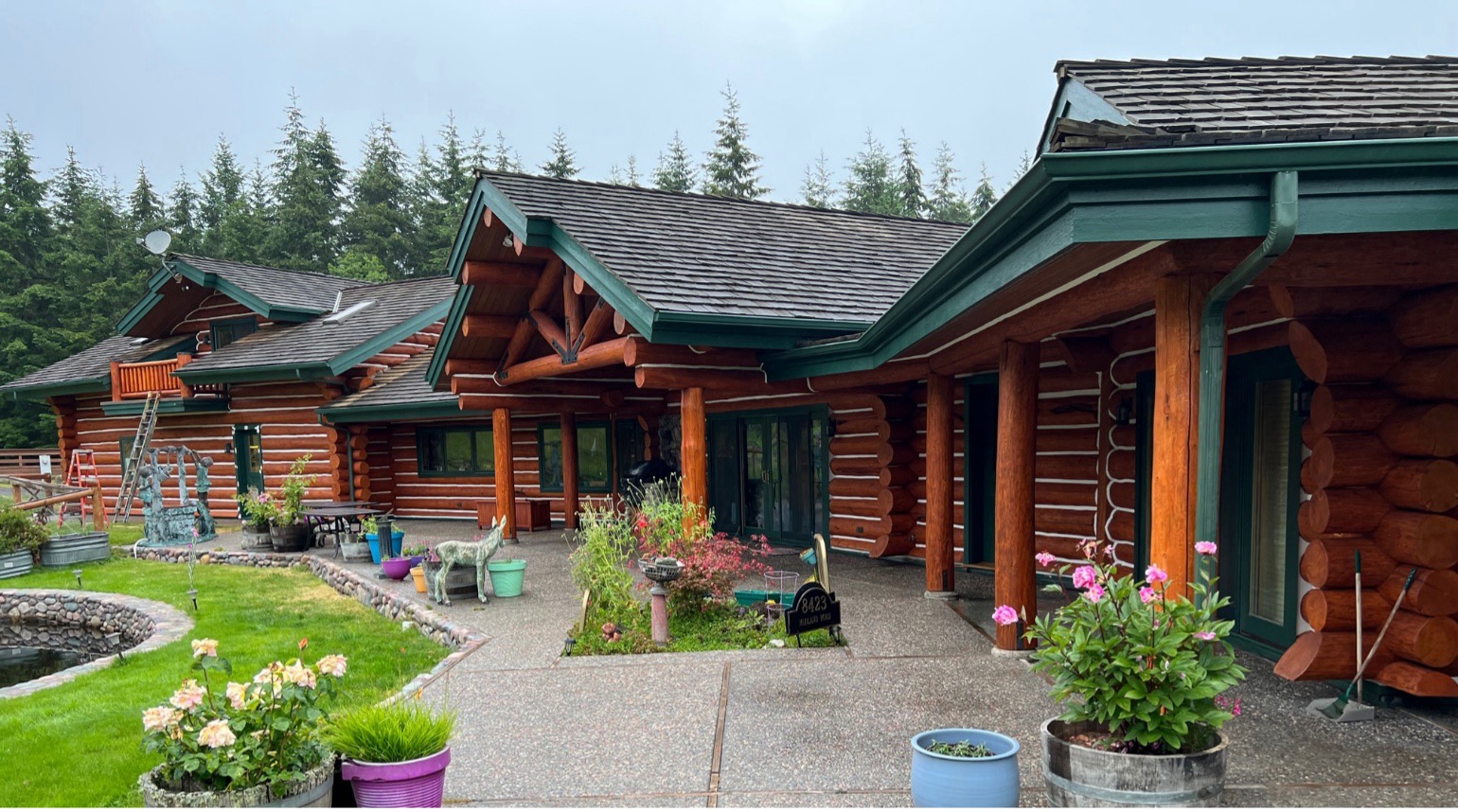One must strip the wood, then restore it to its original beauty. Here’s what that process looks like:
Stripping: From Grimy to Gleaming
When faced with the need to return logs to their original bare wood form, a homeowner has three options for stain removal: 1) media blasting, 2) chemical stripping and 3) sanding. Each comes with its own pros and cons.
Media Blasting
Media blasting uses abrasive materials propelled by compressed air. Many types of materials are used in media blasting such as walnut shells, glass or plastic beads, ceramics, copper cut wire, and corn cobs, to name a few.Most contractor professionals prefer media blasting over other stain stripping options. That’s because it’s a fairly quick process and does a reliable job of stain removal, even in hard-to-reach spaces like corners and dovetails. It’s also a clean, dry removal process in that it does not introduce a liquid rinse or chemicals.

The downside of media blasting is the price tag. The two-person operation requires an industrial compressor and other steps are involved. The blast materials leave the wood pitted and feathered, which opens the wood’s porosity. A primer and buffing or sanding are required to smooth out the surface.
Chemical Stripping
One of the immediate benefits of chemical stripping is its friendlier cost. Not only is it less expensive than media blasting, but it also leaves the wood’s surface and natural color intact.The downsides depend on the type of chemical stripper. You would not want to use a harsh chemical stripper near lakes or streams or any water that can carry the chemicals into the watershed. Some homeowners’ associations (HOAs) don’t permit chemical strippers for this reason.
There are newer chemical strippers that are more environmentally friendly, and Perma-Chink Systems has developed two versions. S-100 is a ready-to-use, water-based, citrus gel solvent engineered to remove oil-type penetrating and water-born products. StripIt is designed to remove multiple layers of paint or stain, both film-forming or a top coat, including Perma-Chink’s Lifeline series. StripIt has zero VOCs and is odor free.

With any chemical stripper, it’s important to determine the “dwell time” on the wood and stain. Dwell time refers to how long a stain must sit on the log’s surface before removing or rinsing and can range from 10 minutes to several hours. The amount of time will vary depending on the chemical product, the type of paint or stain it’s removing, the wood species and age, how many layers it needs to dissolve, and even the wood’s exposure to weather and UV rays. Be sure to get a sample to test on the log to accurately determine the dwell time.
Sanding
Sanding is an excellent method for returning to bare wood as it provides a very uniform finish and it’s quite affordable. However, sanding is extremely labor intensive, requiring a lot of old-fashioned elbow grease. Getting into the corners and dovetails effectively will require a little extra attention.
Restoring: From Bare to Beautiful
Once all paint or stains have been removed, the wood is ready to begin prepping for a new stain. It’s a simple process:- Clean with Log Wash to ensure the logs are free from dust, pollen, dirt, or any residual particulate matter leftover from the stripping process. Just spray it on and rinse it off with a hose.
- Treat the logs with borates, like Bora-Care or PenaShield, to protect the wood from fungi decay and insects that ingest wood (e.g., wood-boring beetles, carpenter ants and termites).
- Apply sealants and finish for beauty and longevity. Perma-Chink’s Lifeline wood finishes come in a wide array of colors so you can achieve the perfect look. You can also match the log’s natural color to the stain to get a natural look while retaining the stain’s protective UV properties. Order your free samples here.
- Finish with Lifeline Advance for that deep sheen that protects the stain and makes a log home’s aesthetic sing.

Ready to return your log home to its rightful glory? Using the right products for stripping and restoration can transform a weathered structure into something truly remarkable while providing long-lasting, low-maintenance protection for years to come. That’s the beauty of Perma-Chink Systems.
Follow along! Join Perma-Chink Systems, Inc. in this exclusive Ask the Expert series to get answers to all your top questions about staining, sealing, maintenance and more!
Sponsored by Perma-Chink Systems, Inc.











